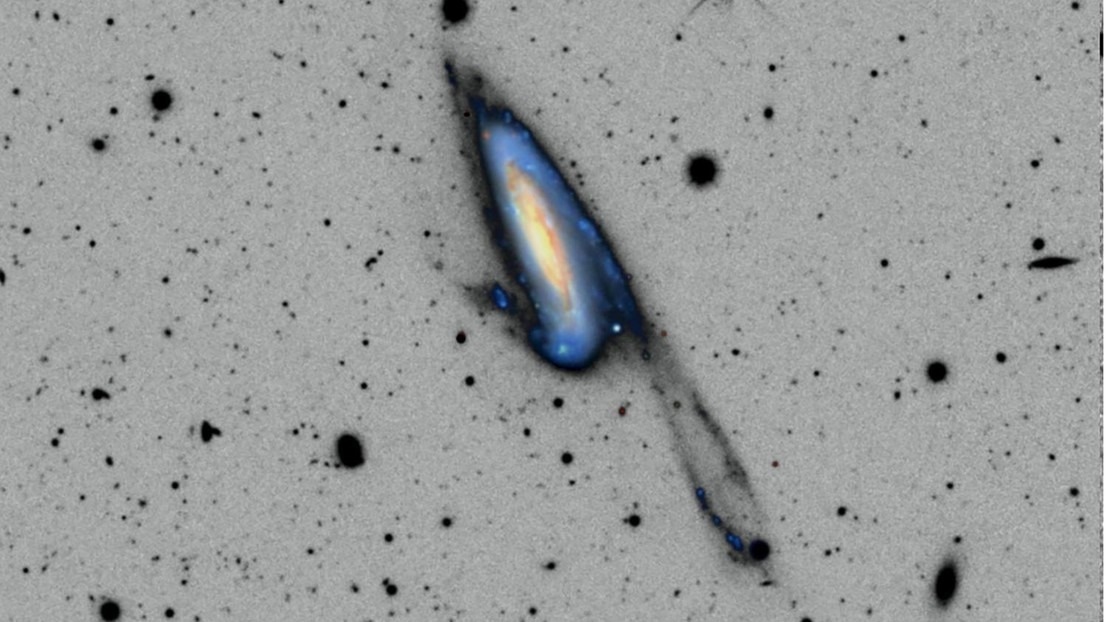The ARRAKIHS consortium, of which EPFL is the science lead, has just completed the project’s mission definition review, a critical first step toward full completion of mission planning. ARRAKIHS is an ESA-selected spacecraft that will be launched in 2030 to investigate the nature of dark matter.
 Example of stellar shells and tidal streams in the halo of nearby galaxies from ground-based images. ARRAKIHS will allow imaging 10 times deeper. Image Credit: 2023 Martinez, Delgado et al.
Example of stellar shells and tidal streams in the halo of nearby galaxies from ground-based images. ARRAKIHS will allow imaging 10 times deeper. Image Credit: 2023 Martinez, Delgado et al.
Some stars in the night sky are remnants of the universe’s early stages of development and might have been among the first small galaxies to form. These are incredibly dim structures in the night sky, and it is known now that dark matter also dominates them. Matter that is invisible but has been found gravitationally is known as dark matter.
Specific and focused observational techniques are needed to recognize and describe these structures. Since these incredibly faint structures hold the key to understanding the nature of dark matter, ESA’s second “F” space mission, ARRAKIHS, will search for them over the course of the next ten years.
ESA calls it an F-mission, where F is for fast.
Pascale Jablonka, Adjunct Professor, Laboratory of Astrophysics, EPFL
ARRAKIHS must satisfy several requirements to be classified as an F-class mission: it must be stand-alone, ESA-led, have a total cost to ESA of less than 175 million euros (including operations); it must be developed using a design-to-cost methodology; and it must take less than eight years from mission selection in November 2022 to launch.
The European consortium members of ARRAKIHS, directed by Spain with a substantial component from Switzerland and selected by ESA in 2022 as the second F mission, have been collaborating over the past year to finish the mission study’s first phase, or phase zero.
With the successful completion of its first milestone, the “mission design review,” on September 27, the ARRAKHIS consortium and the ESA study team were able to proceed to the following stages of the project.
Jablonka added, “We are very excited! It is a happy and emotional moment to get past this first phase. It means that the mission is now concretely valued. We are entering an even more active phase of the project, for which we need support from the national agencies.”
The Mission Consortium, in collaboration with ESA and Industry, will work for the next 2.5 years on the next study phase, known as mission definition or Phase A/B. This phase covers the definition of all mission components, including science, the science instrument, the spacecraft, and operations. After extensive research on mission viability, teams of independent scientists and engineers will evaluate the results.
If it is successful, ESA will next recommend that ARRAKIHS be adopted and put into action by its Science Program Committee, which is composed of delegates from each of the ESA member nations.
Unveiling the Invisible with ARRAKIHS
As to the current standard cosmological model, which relies on Einstein’s theory to regulate gravitation, the universe is composed of 75% dark energy and 27% dark matter. The remaining 5% is made up of ordinary matter, which includes planets and stars.
The abbreviation ARRAKIHS (Analysis of Resolved Remnants of Accreted Galaxies as a Key Instrument for Halo Surveys) indicates the sci-fi planet in the novel Dune, but instead of seeking “spice,” this low-Earth orbit satellite will be looking to reveal one of contemporary physics’ deepest mysteries.
Empirical research has demonstrated that the quantity of faint dwarf systems around giant galaxies, like the Milky Way, and the stellar streams within their halos bear a signature of the nature of dark matter. Consequently, ARRAKIHS will focus on 75 of these Milky Way analogs. However, because these analogs are so incredibly weak in the night sky, it is crucial to view them from space, away from the atmosphere of Earth.
The faintness of the astrophysical structures presents an engineering problem for scientists as they attempt to identify and describe the features of the star halo with the use of highly efficient imaging technologies.
The next step is to do a comparison between these observations and the predictions of different dark energy models. Over the course of 150 hours, every galaxy will be studied in depth, and its halo structures will be deciphered.
Jablonka added, “The mission is especially exciting for me and my collaborators since it brings together many areas of our research interests, like dark matter and galaxy evolution, but also image processing and numerical simulations.”
Jablonka became interested in astrophysics because “it combines outstanding beauty and fundamental questions about the formation and evolution of physical systems.”